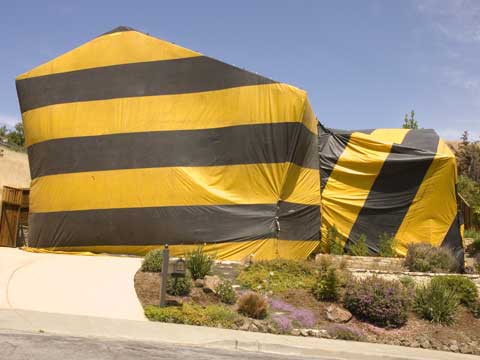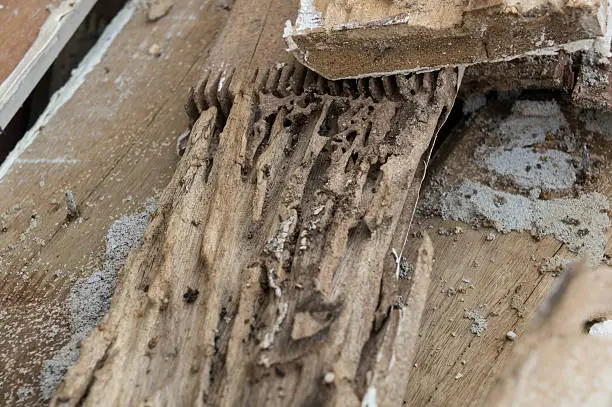

Orange oil is an eco-friendly alternative to traditional termite treatments, effectively eliminating termites without the use of harmful pesticides or fumigation. This natural method utilizes the power of orange oil, which is derived from orange rinds, to target and eradicate termites from exposed wood structures. Our trained technicians begin with a comprehensive inspection of your property to identify termite activity. Once termites are detected, the orange oil is injected directly into the affected wood, ensuring deep penetration to reach both termites and their eggs.
Our termite specialists conduct a thorough inspection to pinpoint active termite infestations. After identifying affected areas, orange oil is carefully injected into the exposed wood. The oil spreads throughout the wood fibers, effectively reaching hidden termites and their eggs. The key component, d-limonene, destroys termites by breaking down their cell membranes, leading to their rapid elimination. Following treatment, our technicians re-inspect the treated areas to confirm the infestation has been eradicated and provide recommendations for any follow-up actions if necessary.

Technicians at Southland Pest Control are highly trained and state-licensed, ensuring they have the expertise to handle any termite infestation effectively. Continuous education and training keep them updated on the latest pest control methods.
After the initial termite treatment, we offer follow-up services to monitor the effectiveness of the treatment and address any recurring issues. Regular check-ups ensure a long-term solution to termite problems.
Experience Top-Quality Pest Control & Prevention – Safe, Effective, and Long-Lasting!
Keep your home pest-free with Southland Pest Control’s reliable and customized solutions for all types of unwanted intruders.
Protect your property from costly termite damage with Southland Pest Control’s advanced detection and treatment solutions
Say goodbye to rats, mice gophers and squirrels with Southland Pest Control’s expert rodent removal and prevention services.
Protect your home and family from the nuisance and health risks of mosquitoes with Southland Pest Control's effective and eco-friendly mosquito control solutions

Fumigation is a highly effective method for eliminating widespread termite infestations. The structure is sealed with a tent for 24-48 hours while Vikane gas is introduced, replacing oxygen and penetrating deep into walls, attics, and hidden spaces. Once the treatment is complete, our technicians air out the structure and conduct a thorough inspection before allowing occupants to return. This treatment is backed by a 3-year warranty for long-term protection.
Heat treatment offers a chemical-free alternative for termite extermination. This method raises the temperature inside the structure to levels that are lethal to termites, ensuring they are eliminated without the use of pesticides. Unlike fumigation, heat treatment can be completed in just a few hours, and occupants can return to their home on the same day.


For smaller infestations, localized spot treatments provide a targeted and cost-effective solution. After inspecting the affected areas, our technicians apply a specialized treatment directly to the infested wood. This method requires little to no preparation and does not require evacuating the home, making it a convenient option for homeowners dealing with isolated termite activity.

Orange oil treatment is an excellent choice for those looking for a natural and low-toxicity approach to termite control. Unlike traditional fumigation, this method does not require you to vacate your home or business, making it an ideal solution for families with children, pet owners, and commercial establishments that cannot afford downtime. The targeted application process minimizes waste, focusing only on the infested areas, and does not require tarping or extensive preparation. This efficient and minimally invasive process ensures a quick return to normal daily activities while effectively eliminating termites.
If you suspect termite activity in your home or business, scheduling an inspection is the first step. Our expert technicians will assess the severity of the infestation and determine if orange oil treatment is the best option for your situation. While highly effective for localized infestations, severe or widespread termite problems may require additional or alternative treatments. We are committed to providing organic and effective termite control solutions to protect your property and give you peace of mind.
Our team is fully trained and licensed to secure your home from invasive termites.
Before buying or selling a property in LA & Riverside County, a full termite inspection is essential to ensure there are no hidden infestations or structural damage. Our licensed termite inspectors provide detailed evaluations of residential and commercial properties, checking key areas such as foundations, attics, crawl spaces, and basements. We understand the urgency of real estate transactions and typically deliver reports within 24-48 hours. Whether you are a buyer looking to protect your investment or a seller ensuring transparency, our professional inspections help facilitate a smooth transaction.
Termites and other wood-destroying pests can significantly weaken a home’s structure, making it more susceptible to damage from earthquakes, storms, and other natural forces. Unchecked infestations can reduce wood strength by up to 80%, leading to costly and potentially irreparable damage. Common termite trouble spots include cracks in concrete foundations, wood in direct contact with soil, excess moisture, and stacked firewood near the home. Our professional inspections can identify these vulnerabilities early, allowing homeowners to take proactive steps to safeguard their property from extensive termite damage.
We make pest control simple, effective, and hassle-free.
Here’s what you can expect when working with Southland Pest Control:
Our expert technicians thoroughly inspect your property to identify pest activity, entry points, and risk factors.
We use industry-leading, family- and pet-safe treatments to eliminate pests without harming the environment.
We offer follow-up services, preventative treatments, and expert advice to keep pests from coming back.
We develop a targeted solution based on the type of infestation, property layout, and your specific needs.
Our team applies treatments strategically for maximum effectiveness, ensuring long-lasting protection.
Your peace of mind is our priority! We stand behind our services with warranties and customer support.

Copyright © 2025 Southland Pest Control. All rights reserved.
Pest Control Marketing by Streamline Results